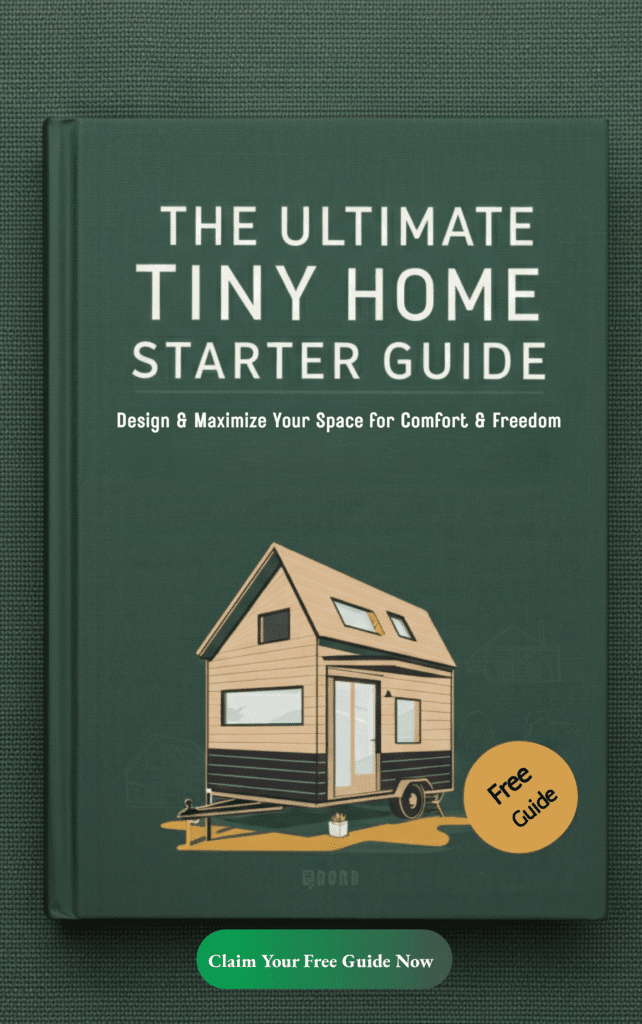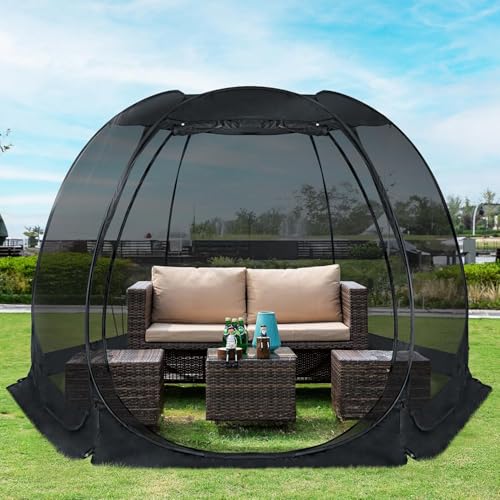What makes minimalist tiny houses so appealing? These compact homes, typically between 100 and 400 square feet, prioritize efficiency and sustainability. In this article, we’ll explore their core features, benefits, and why an increasing number of people are choosing this economical and eco-friendly lifestyle.
You’ll love the inspiration and ideas we’ve gathered to help you imagine your own minimalist tiny house journey.
Key Takeaways
- Minimalist tiny houses, ranging from 100 to 400 square feet, promote sustainable living by encouraging reduced consumption and a smaller carbon footprint.
- The affordability and financial freedom offered by tiny homes, combined with their energy efficiency, make them an attractive alternative to traditional housing.
- Key features, costs, and regulations of minimalist tiny houses include space optimization, eco-friendly materials, and versatile designs, which may vary depending on location, design, or individual needs, enabling comfortable, practical living in compact spaces.
- Understanding Minimalist Tiny Houses
- Why Minimalist Tiny Houses Are Gaining Momentum
- Key Features of Minimalist Tiny Houses
- Financial Freedom with Minimalist Tiny Houses
- Embracing a Minimalist Lifestyle
- The Flexibility of Minimalist Tiny Houses
- Inspiring Models of Minimalist Tiny Houses
- Summary
- Frequently Asked Questions
Understanding Minimalist Tiny Houses
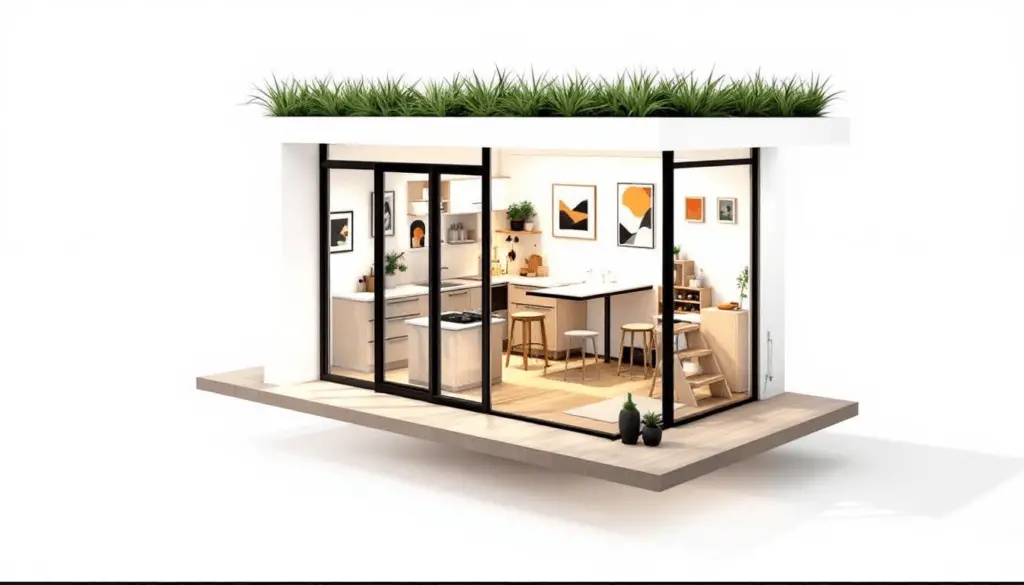
Minimalist tiny houses are compact living spaces. They usually range from 100 to 400 square feet. These homes represent a significant shift from traditional housing, focusing on downsizing physical space to enhance the quality of life.
Before choosing a minimalist tiny house, it is important to take time to understand your own needs and priorities to ensure the space aligns with your lifestyle.
Prioritizing functionality and simplicity, tiny homes capture the essence of minimalism, promoting fewer possessions and more meaningful experiences.
Why Minimalist Tiny Houses Are Gaining Momentum
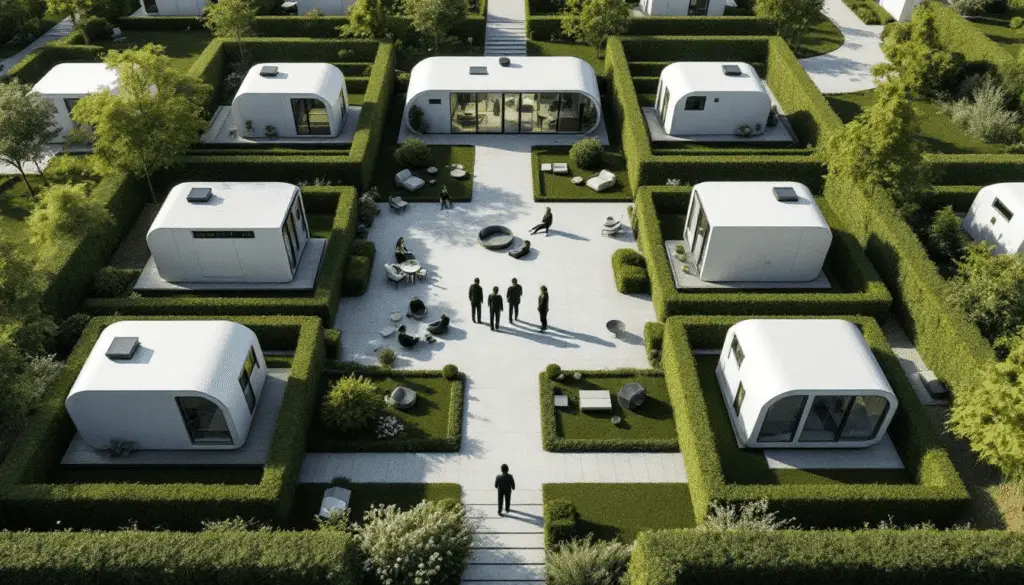
The growing popularity of the tiny house movement is driven by a collective desire for more sustainable and simplistic living options. Environmental consciousness plays a crucial role, as tiny homes typically have a reduced carbon footprint compared to traditional housing. Additionally, the affordability of tiny houses is a significant draw, with construction costs being substantially lower than those of conventional homes.
Many people are looking to find the right minimalist tiny house or location that best fits their lifestyle and needs.
Remote work trends have boosted interest in tiny homes, which offer spaces suitable for living and working. Rising housing costs and the search for affordable options are leading many to consider tiny houses as a viable solution. The trend of small-space living is also driven by the desire for simpler lifestyles and cost-effective living arrangements.
Choosing a often results in less consumption and reduced waste, aligning with the broader cultural shift towards sustainability. The popularity of minimalist tiny houses is a response to the combined demands for sustainability, affordability, and adaptability in contemporary living.
Key Features of Minimalist Tiny Houses
Minimal tiny houses are designed with efficiency and functionality at their core. The emphasis on effective design ensures that every inch of space is utilized to its fullest potential, making these compact living spaces not only comfortable but also highly practical.
Minimalist tiny houses are built with quality materials and are designed to meet high standards of safety and durability. Additionally, they incorporate premium materials and energy-efficient technology, ensuring both comfort and sustainability.
Space optimization, eco-friendly materials, and energy efficiency are key features of minimalist tiny houses, reflecting a commitment to sustainable living.
Space Optimization Techniques
In a smaller space, clever storage solutions are essential. Adding shelves and cabinets high up utilizes vertical space, allowing for effective organization in tiny homes. Installing shelves in the unused space above doorways can provide additional storage for books and decorative items, while hooks on doors help keep small items organized and off the floor.
Spaces beneath sofas and beds offer excellent hidden storage in tiny homes. Multi-functional furniture is essential, serving multiple purposes to maximize space and maintain comfort. These innovative solutions ensure that even the smallest spaces can be both functional and inviting.
Natural light is crucial for creating a sense of spaciousness. Contemporary tiny house designs often incorporate large windows, allowing for an abundance of natural light and enhancing the overall feel of the space. Using light colors on walls and floors further contributes to a more open and airy atmosphere.
Eco-friendly Materials and Construction
By using sustainable materials and designs, these tiny homes align with the principles of sustainability. Many of these homes focus on using materials that minimize environmental impact, ensuring that the construction process aligns with the principles of sustainability. Tiny homes use fewer materials overall. As a result, they help reduce the environmental footprint. Many small towns are more open to allowing tiny houses than larger cities, recognizing their potential to address housing challenges and promote eco-friendly living.
Many tiny homes incorporate reclaimed or recycled materials, extending the commitment to eco-friendly construction. This approach not only reduces waste but also supports the broader goal of sustainable living, making tiny houses an environmentally responsible choice for those seeking a greener lifestyle.
Energy Efficiency and Sustainability
Designed to use fewer resources, minimal tiny houses reduce environmental impact. Utilizing fewer materials in the construction of tiny homes contributes to a more sustainable building approach. Energy-efficient water heating systems and appliances are commonly included in the design, helping to lower overall energy consumption.
Tiny homes’ smaller size results in lower utility bills and less maintenance. With less power needed for heating and cooling, owners can enjoy significant savings on their energy bills. This energy efficiency not only minimizes expenses but also supports a lifestyle that prioritizes sustainability and reduced waste.
Compact homes use less energy for heating and cooling, enhancing environmental benefits. Tiny houses can also use alternative energy sources like solar panels and rainwater catchment systems, further reducing their carbon footprint. By adopting energy-efficient practices and sustainable living principles, tiny house owners can significantly reduce their carbon footprint and contribute to a more sustainable world.
Financial Freedom with Minimalist Tiny Houses
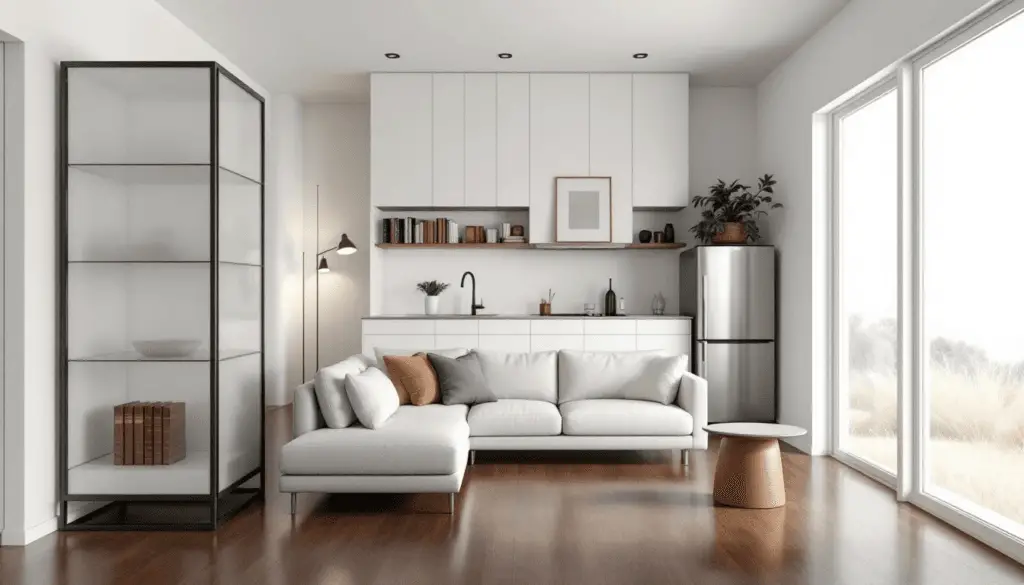
A compelling reason to embrace the tiny house movement is the financial freedom it offers. Tiny houses can significantly reduce initial housing costs, often costing less than half of a traditional home. Spur, Texas declared itself the nation’s first tiny-house-friendly town in 2014, aiming to revitalize the community and promote this affordable housing option. Choosing a tiny house reduces debt and financial pressure, allowing for more comfortable living with less stress from mortgages and ongoing expenses.
Partnering with a reputable company can help ensure your minimalist tiny house meets quality and safety standards.
Many who transition to a minimalist lifestyle in tiny homes report increased happiness and financial freedom.
Affordable Housing Alternative
Compared to traditional housing, tiny homes offer an affordable option. A tiny home is typically less than 400 square feet, with an average size in the U.S. around 225 square feet.
Affordable prefab homes are a practical and cost-effective solution for those looking to embrace tiny living on a budget.
However, obtaining the proper permit is essential to ensure your tiny home is both legal and remains an affordable housing option. Many local governments struggle with zoning laws regarding tiny houses, which can complicate the process of securing permits. Some cities have started easing zoning laws to accommodate tiny houses, making it easier for individuals to transition to this lifestyle. Understanding these regulations is crucial for a smooth transition to tiny living.
Reducing Utility Costs
Financial benefits of tiny homes go beyond initial construction costs. They typically require less energy for heating and cooling, leading to lower utility costs. The reduced square footage leads to lower utility bills and less maintenance, making tiny homes an excellent option for those looking to minimize expenses.
Overall, tiny homes support a lifestyle that prioritizes energy efficiency and cost savings.
Investment and Rental Opportunities
Tiny homes offer unique investment and rental opportunities. Renting out tiny homes as vacation rentals offers financial opportunities for owners, providing a reliable source of income. The originality and lifestyle tiny houses represent make them attractive to renters, ensuring steady demand.
Some companies deliver fully finished tiny homes directly to your property, streamlining the investment process. Additionally, some builders document construction by taking photos of everything inside the walls for future inspections, ensuring transparency and ease of maintenance.
Tiny home rentals usually incur lower maintenance and management costs compared to regular-sized properties. This not only maximizes the financial benefits but also makes tiny home rentals a practical and profitable investment for owners.
Embracing a Minimalist Lifestyle
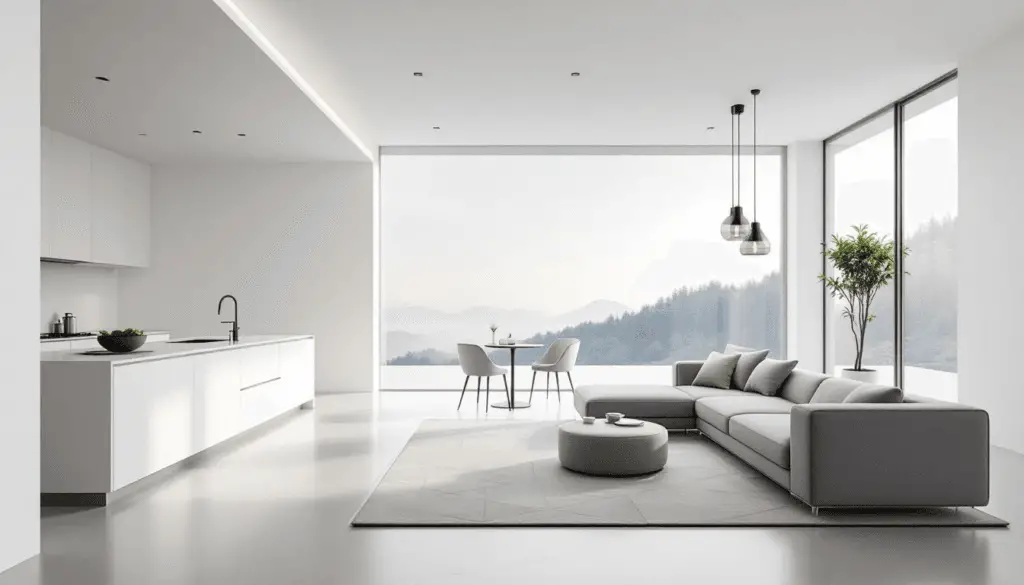
The tiny house movement is more than just a trend; it promotes a lifestyle prioritizing sustainability, minimalism, and experiences over material goods. Tiny home living fosters a sense of freedom by encouraging focus on essential living and reducing material burdens.
Transitioning to tiny house living is an experience that can be both rewarding and transformative, offering a supportive and seamless journey toward a simpler life.
The cultural shift towards minimalism supports this movement, with more individuals prioritizing meaningful experiences over excessive possessions.
Decluttering and Simplifying Lives
A tiny home lifestyle encourages regular decluttering to maintain a manageable amount of possessions. Consistently evaluating and reducing clutter helps individuals focus on what truly matters. Tiny house projects can also provide a path to ownership for tenants in certain developments, addressing asset inequality and promoting financial stability.
Maintaining a minimalist mindset transforms lives, leading to a simpler, more intentional lifestyle.
Psychological Benefits of Minimalism
Adopting a minimalist lifestyle choice through tiny living brings numerous psychological benefits. Conscious living that reduces the carbon footprint, a hallmark of the tiny house movement, fosters a sense of responsibility and well-being.
Minimizing expenses and focusing on a simpler life often reduces stress and increases happiness, making the minimalist approach beneficial for mental health.
Creating a Comfortable Home in Limited Space
A comfortable ambiance is essential to make a tiny home feel inviting. Natural materials in tiny homes positively contribute to the overall ambiance and feel. The use of versatile spaces, like the WorkPod mini, which can function as a home office, extra bedroom, yoga studio, or entertainment space, adds to the comfort and practicality of tiny living.
Incorporating personal style elements while maintaining functionality ensures even the smallest spaces are cozy and efficient. Balancing aesthetics with practicality allows every room to serve multiple purposes without compromising comfort.
The Flexibility of Minimalist Tiny Houses
One of the standout benefits of minimalist tiny houses is their flexibility. These homes are often portable, providing the opportunity for travel without losing the comfort of home. Tiny houses can be built on wheels or on fixed foundations, offering residents the choice between mobility and permanence. The ability to move easily allows residents to explore different living conditions and locations without the hassle of buying or selling property.
This flexibility means residents can select their ideal location and adapt to various environments, making it easier to personalize their living experience based on geographic preferences.
Mobility and Travel-Friendly Designs
Lightweight materials in minimal tiny homes ensure easy transport and enhance mobility. Foldable furniture maximizes space during travel, making these homes ideal for a nomadic lifestyle. The appeal of tiny homes extends to renters as well, who are drawn to the distinctive style and lifestyle they offer. Mobile Loaves & Fishes in Austin, Texas, built over 100 tiny houses for rent, targeting low-income individuals and the homeless, showcasing how these homes can serve diverse needs.
Some tiny houses are classified as RVs, which can influence their legal status and mobility options depending on local regulations. Tiny houses on wheels are often classified differently than those on foundations, which may affect zoning and building requirements. Tiny house builders often follow uniform building codes or a similar set of standards for RVs, ensuring safety and compliance regardless of their classification.
A mobile tiny house offers flexibility and the opportunity to travel without losing home comforts. Owners can also profit by renting tiny houses as vacation properties, capitalizing on their unique appeal and generating additional income.
Versatile Living Arrangements
Tiny homes can easily be tailored to diverse living arrangements, accommodating single occupants or small families. The compact nature of tiny homes allows for versatile multi-purpose spaces for work, leisure, or relaxation.
This adaptability ensures that tiny house living can suit various lifestyles and needs, making it a viable option for many. However, tiny houses may not be ideal for all families, particularly those with kids, due to limited space and privacy.
Inspiring Models of Minimalist Tiny Houses
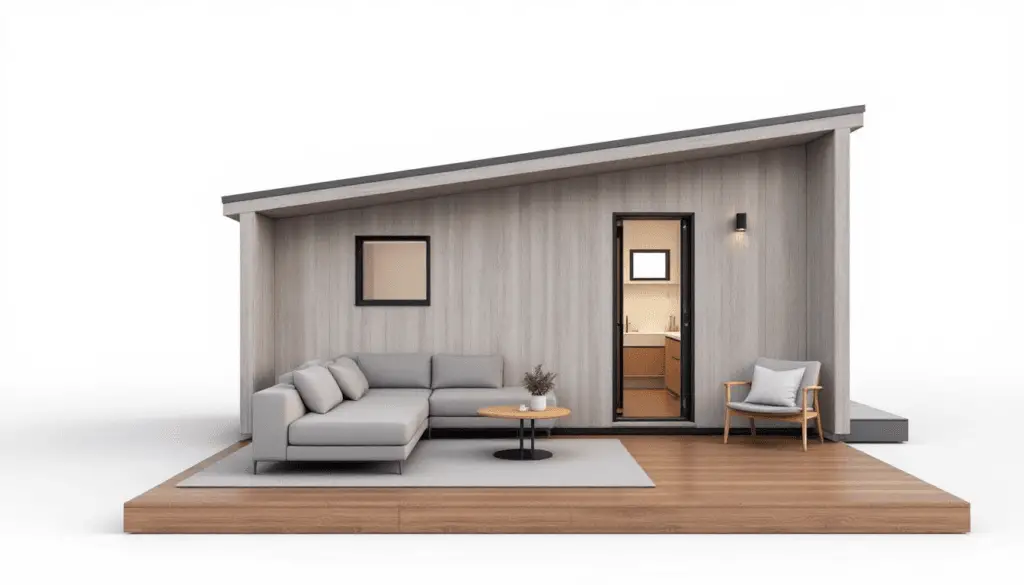
The tiny house movement has inspired innovative models that showcase the potential of sustainable living. These designs emphasize simplicity, efficiency, and aesthetic appeal, offering both practical and beautiful living spaces. The tiny home movement continues to grow, attracting those interested in downsizing and embracing a minimalist lifestyle.
Each minimalist tiny house model can be approached as a unique project, allowing for customization to reflect the owner’s vision and specific needs.
From modern minimalist designs to rustic homes and prefabricated units, there are options to suit different tastes and needs.
Modern Minimalist Designs
Modern minimalist tiny house designs focus on simplicity and efficiency, creating beautiful yet functional living spaces. The Weekender by Nordic & Spruce, for example, features a modern gable shape, designed for both vacation rentals and minimalist living. Another example is the Coastal Cozy from Tiny Home & Co, which includes a chic, modern interior designed for 1-2 people.
These modern designs balance aesthetics with practical living solutions, tailored to the needs of contemporary dwellers. Embracing modern minimalist designs contributes to sustainable living, promoting efficient use of resources and space.
The Halcyon by Fritz Tiny Homes is another model that blends luxury and functionality, featuring an open-plan layout and ample storage.
Rustic and Cozy Minimalist Homes
Rustic and cozy designs in minimal tiny houses create an inviting atmosphere that emphasizes warmth and simplicity. The Timber Cabin by Made By Hideaway is a prime example of minimalist design that features rustic elements like natural wood finishes. This model boasts a warm interior layout, fostering a sense of comfort and intimacy, ideal for couples. Some rustic minimalist tiny houses also feature a porch, providing additional outdoor living space and enhancing the home’s charm.
Rustic charm blended with cozy interiors makes minimalist tiny houses appealing for sustainable living. These designs not only offer a comfortable living environment but also align with the principles of minimalism and sustainability.
Prefabricated Minimalist Units
Prefabricated tiny homes are available in various designs, allowing for quick assembly and affordability. These homes are designed for fast and efficient housing solutions, making them ideal for those seeking immediate housing options. The Shaka Shack by Tiny By Taylor, for instance, is a lightweight, cost-effective prefab tiny house designed for 1-2 people.
Prefabricated minimalist units are affordable and easy to assemble. Many tiny houses are crafted off-site, sometimes without a predetermined location, allowing for flexibility in placement. These homes offer a practical solution for those looking to embrace tiny living without the lengthy construction process, making them a popular choice in the tiny house movement. Homeowners can start enjoying tiny house living soon after purchase, thanks to the quick setup of these prefabricated units.
Summary
The journey through the world of minimalist tiny houses reveals a compelling case for sustainable and simplified living. These homes offer numerous benefits, including environmental sustainability, financial freedom, and a minimalist lifestyle that prioritizes meaningful experiences over material possessions. Tiny houses can foster a sense of community among residents, creating a supportive and connected living environment. With their innovative designs and versatile living arrangements, tiny houses provide a viable alternative to traditional housing, appealing to those seeking a more intentional and eco-friendly way of life. Embracing the tiny house movement can lead to a more fulfilling, sustainable, and enriched lifestyle. Minimalist tiny houses also offer the opportunity to stay in a comfortable, sustainable home for the long term.
Frequently Asked Questions
What is the size range of a minimal tiny house?
Minimalist tiny houses generally vary in size from 100 to 400 square feet. This compact range supports a simplified and efficient lifestyle.
How much can I save by living in a tiny house?
Living in a tiny house can save you over 50% on initial housing costs, along with reduced utility and maintenance expenses. These minimalist tiny houses are designed to last and withstand the test of time, making them a durable investment. Durability is emphasized in their construction, with features like reinforced steel frames and weatherproof exteriors ensuring long-term reliability. This approach not only minimizes your financial burden but also promotes a simpler lifestyle.
Are tiny houses eco-friendly?
Indeed, tiny houses are eco-friendly as they utilize sustainable materials and consume fewer resources for construction and upkeep. This minimalist approach significantly reduces environmental impact. Eco-friendly tiny houses are also built to be safe, meeting modern safety standards to ensure occupant protection.
Can I travel with my tiny house?
Yes, you can travel with your tiny house, as many are designed for portability, allowing for easy relocation while retaining home comforts.
What are some popular models of minimal tiny houses?
Popular models of minimalist tiny houses include The Weekender by Nordic & Spruce, Coastal Cozy by Tiny Home & Co, and the Timber Cabin by Made By Hideaway. These designs exemplify efficient living while maintaining aesthetic appeal.

